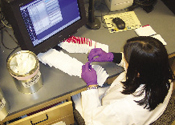mtDNA
DNA—Mitochondrial
Mission
The DNA Analysis Unit II (DNAAU-2) examines biological items of evidence from crime scenes to determine the mitochondrial DNA (mtDNA) sequence from samples such as hair, bones, and teeth. Typically, these items contain low concentrations of degraded DNA, making them unsuitable for nuclear DNA examinations. DNAAU-2 also maintains the National Missing Person DNA Database (NMPDD) program for the identification of missing and unidentified persons and the Scientific Working Group DNA Analysis Methods (SWGDAM) mtDNA Population Database, which is an integrated software and database resource for forensic comparison.
The Team
Biologists, forensic examiners, and management and program analysts.
The Work
mtDNA
The high sensitivity of mtDNA analysis allows forensic scientists to obtain information from old items of evidence associated with cold cases and small pieces of evidence containing little biological material. Additionally the maternal inheritance of mtDNA allows scientists to compare the mtDNA profile of a set of remains to that of reference samples from individuals such as the mother, brother(s), sister(s), or any other maternally related individuals of a missing person. These samples should have the same mtDNA profiles because all maternal relatives inherit the same mtDNA. Since mtDNA is maternally inherited and multiple individuals can have the same mtDNA type, unique identifications are not possible using mtDNA analyses. However, mtDNA is an excellent technique to use for obtaining information in cases where nuclear DNA analysis is not feasible.
National Missing Persons DNA Database (NMPDD)
On May 4, 2001, the Laboratory Division initiated the NMPDD program for the identification of missing and unidentified persons using the National DNA Index System (NDIS) of the Combined DNA Index System (CODIS). The NMPDD contains three parts in which missing and unidentified person DNA profiles can be entered: biological relatives of missing persons, unidentified human remains, and missing persons.
Regional mtDNA Labs
The FBI Laboratory has partnered with four regional crime laboratories to augment the nation's capacity to perform mtDNA analysis in forensic and missing person cases. This analysis is conducted free-of-charge to state and local law enforcement agencies.
Scientific Working Group of DNA Analysis Methods (SWGDAM) mtDNA Population Database
DNAAU-2 maintains the SWGDAM mtDNA Population Database.







